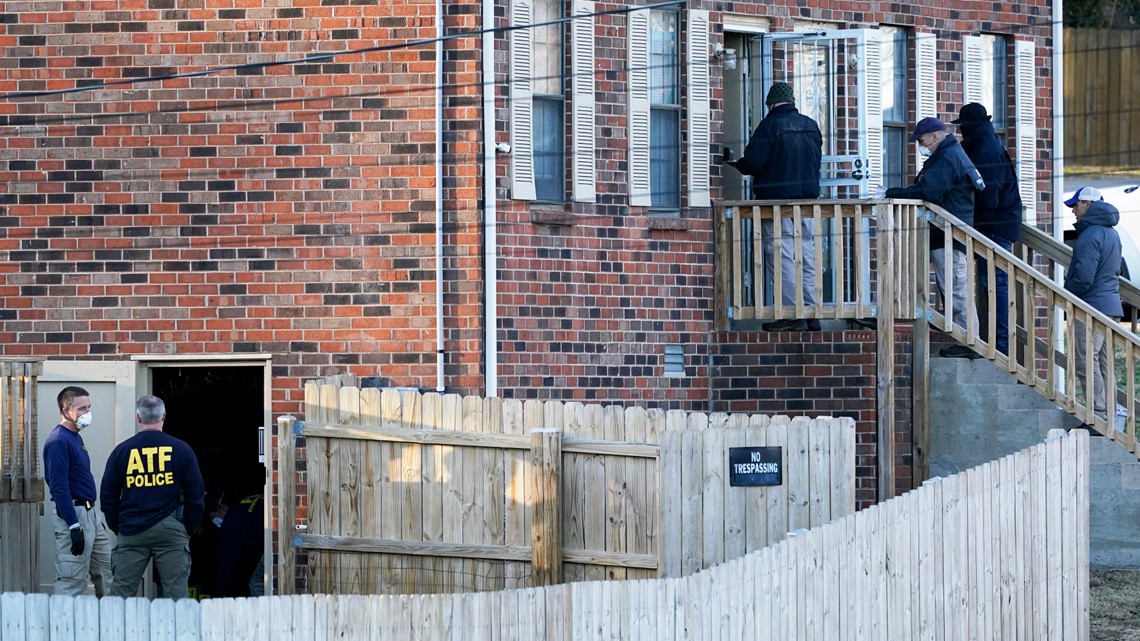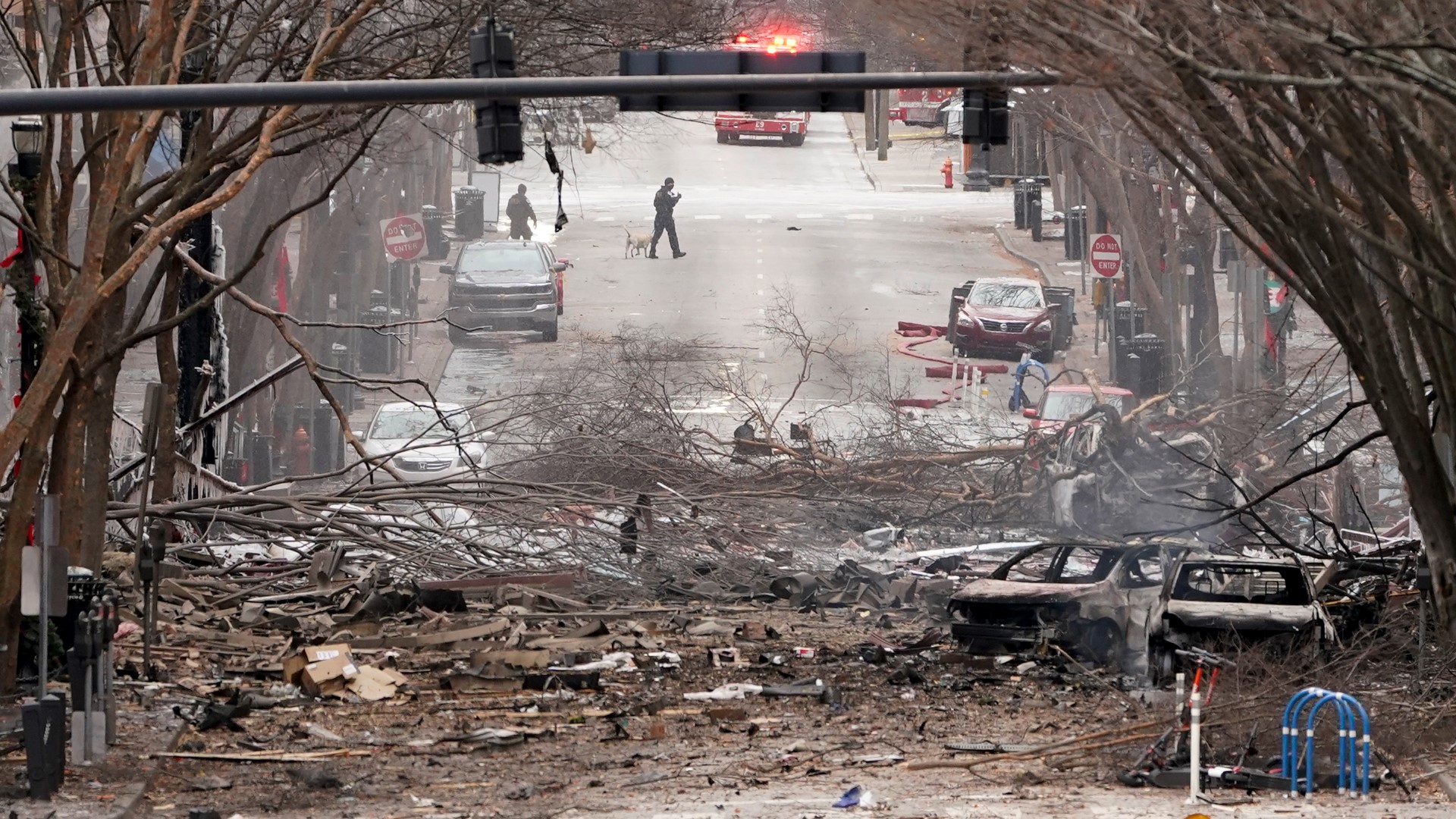NASHVILLE, Tenn. — Federal agents converged Saturday on the home of a possible person of interest in the explosion that rocked downtown Nashville as investigators scoured hundreds of tips and leads in the blast that damaged dozens of buildings on Christmas morning.
Nashville Police say a Tennessee man named Anthony Quinn Warner is under investigation in connection with the Christmas Day bombing that rocked downtown Nashville.
Metro Nashville Police Department Spokesman Don Aaron confirmed Warner's identity Sunday. Federal and state investigators are trying to determine who set off a bomb inside a recreational vehicle Friday morning, injuring three people and damaging more than 40 businesses. They are also working to identify human remains found at the scene.
Separately, a law enforcement official told The Associated Press that federal investigators have started examining Warner's digital footprint and financial history. They are also examining a recent deed transfer of a home in suburban Nashville.
The official could not discuss the case publicly and spoke to The Associated Press on condition of anonymity.
The official said forensic analysts are reviewing evidence collected from the blast site to try to identify the components of the explosives and are also reviewing information from the U.S. Bomb Data Center for intelligence and investigative leads.
Federal agents are examining a number of potential leads and pursuing several theories, including the possibility that an AT&T building was targeted. The bomb caused damage that affected communications in several states.
More than 48 hours after the explosion, a motive remained elusive as investigators worked round-the-clock to resolve unanswered questions about a recreational vehicle that blew up on a mostly deserted street on a sleepy holiday morning after a recorded warning advised those nearby to evacuate.
The attack, which damaged an AT&T building, continued to wreak havoc on cellphone service and police and hospital communications in several Southern states as the company worked to restore service.
Investigators from multiple federal and local law enforcement agencies descended on the home in Antioch, in suburban Nashville, on Saturday after receiving information relevant to the investigation, said FBI Special Agent Jason Pack. Another law enforcement official, who was not authorized to discuss an ongoing investigation and spoke to The Associated Press on condition of anonymity, said investigators regard a person associated with the property as a person of interest.
Federal agents could be seen looking around the property, searching the home and the backyard. A Google Maps image captured in May 2019 had shown a similar recreational vehicle parked in the backyard; an AP reporter at the scene did not see the vehicle at the property in the late afternoon Saturday.
There were other signs of progress in the investigation, as the FBI revealed that it was looking at a number of individuals who may be connected to it. Officials also said no additional explosive devices have been found — indicating no active threat to the area. Investigators have received around 500 tips and leads.
“It’s just going to take us some time,” Douglas Korneski, the special agent in charge of the FBI’s Memphis field office, said at a Saturday afternoon news conference. “Our investigative team is turning over every stone” to understand who did this and why.
Investigators said they were working to identify human remains found at the scene. Beyond that, the only known casualties were three injured people.
The infrastructure damage, meanwhile, was broadly felt, due to an AT&T central office being affected by the blast. Police emergency systems in Tennessee, Kentucky and Alabama, as well as Nashville’s COVID-19 community hotline and a handful of hospital systems, remained out of service.
The building contained a telephone exchange, with network equipment in it — but the company has declined to say exactly how many people have been impacted.
Asked whether the AT&T building could have been a possible target, Korneski said, “We’re looking at every possible motive that could be involved.”
Investigators shut down the heart of downtown Nashville’s tourist scene — an area packed with honky-tonks, restaurants and shops — as they shuffled through broken glass and damaged buildings to learn more about the explosion.
Mayor John Cooper has enforced a curfew in the downtown area until Sunday via executive order to limit public access. More than 40 buildings were affected.
AT&T said Sunday it was rerouting service to other facilities as the company worked to restore its heavily damaged building. The company said in a statement that it was bringing in resources to help recover affected voice and data services and expects to have 24 additional trailers of disaster recovery equipment at the site by the end of the day.
Restoration efforts faced several challenges, which included a fire that forced their teams to work with safety and structural engineers and drilling access holes into the building in order to reconnect power.
Ray Neville, president of technology at T-Mobile, said on Twitter Saturday that service disruptions affected Louisville, Nashville, Knoxville, Birmingham and Atlanta. “We continue to see service interruptions in these areas ... Restoration efforts continue around the clock & we will keep you updated on progress,” he said.
The outages had briefly grounded flights at the Nashville International Airport, but service was continuing normally as of Saturday. The Federal Aviation Administration has since issued a temporary flight restriction around the airport, requiring pilots to follow strict procedures until Dec. 30.
According to Metro Nashville Police Chief John Drake, police officers responded on Friday to a report of shots fired when they encountered the RV blaring a recorded warning that a bomb would detonate in 15 minutes. Police evacuated nearby buildings and called in the bomb squad. The RV exploded shortly afterward.
___
Associated Press photographer Mark Humphrey in Nashville and writer John Raby in Charleston, West Virginia, contributed to this report.



